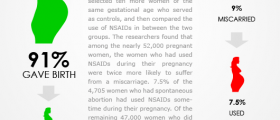
Pain is a displeasing feeling that can be of very low intensity or it can totally intolerable. The sensation of pain depends on both the region that is affected and the reaction of the brain cortex on the impulse.
Pain medication can have different results on every patient and also the tolerance of pain diverges vastly from one to another, so one must take every condition into consideration when prescribing painkillers.
The most common Nonsteroidal Anti-Inflammatory Drugs (NSAIDs) that can be purchased over-the-counter (meaning that buyer does not need a prescription to buy them) are Aspirin, ibuprofen and naproxen. The first two are medications with short term effects while the latter has a prolonged one. That means that one is advised to take Aspirin and ibuprofen for quick pain alleviation while naproxen has a continuing effect.
On the other hand, there are many NSAIDs that can be bought only with prescriptions, such as fenoprofen (Nalfon), Indomethacin (Indocin, Indocin-SR), ketoprofen (Oruvail), piroxicam (Feldene). This category of medications is one of the most marked and sold by drug companies. There is no sure indication that the price of medication is directly connected with its effect. Some NSAIDs are advertised as being superior for some situations.
The most familiar side effect of NSAIDs is the fact that they can create bleeding in the abdomen which is caused by damage of the mucosis. It is largely connected with longer usage. Long-term use could also be the cause of kidney damage. Acetaminophen is the medication that is advised for longer use because he is more secure.
It is familiar that the amount of doses does not augment the pain-relieving effect. For example, 400 mg of Motrin has an equal effect on diminishing the pain as 800 mg of Motrin, but on the other hand, bigger doses increase the danger of stomach bleeding.
Because of the mentioned effect of gut bleeding, drug companies have improved NSAIDs and made the new class of COX-2 inhibitors.
Because of their brief existence on the market, the side effects are not very well researched. It is not known if COX-2 inhibitors cause lesser bleeding in the abdomen. Their pain-relieving characteristics compared to standard NSAILs are not totallyinvestigated. Today only celecoxib (Celebrex) can be purchased, since Valdecoxib (Bextra) and Rofecoxib (Vioxx) were removed from the market because of discovered risks of heart attack, stroke, and skin damage.
Besides COX-2 inhibitors, there are other ways to avoid the risks of stomach complications, such as the prescription of misoprostol (Cytotec) or a proton pump inhibitor, such as Omeprazole (Prilosec), lansoprazole (Prevacid), or esomeprazole (Nexium), with NSAIDs.
Various combinations of medications can be used with different effects because the results differ greatly from one person to another. The main feature that should be taken into consideration is the danger of heart and kidney damage. To relieve the short-term pain and prevent complications at the same time, one could take ibuprofen and afterward Percocet or Vicodin as needed.
For moderately severe pain, one can go for a combination of acetaminophen and narcotics such as codeine, hydrocodone or oxycodone. For severe pain, narcotics are better. The good side is that there is no maximum dosage, but in higher doses they can severely damage the breathing process.











,-Or-Ibuprofen-Which-Over-The-Counter-Painkiller-Should-You-Choose_f_280x120.jpg)





Your thoughts on this
Loading...